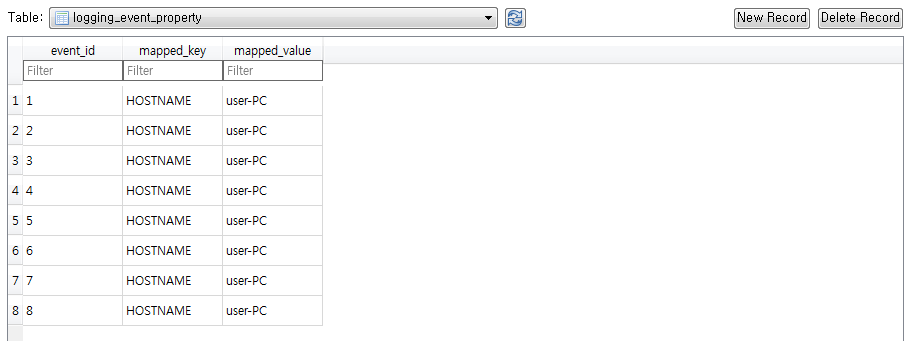4.DBAppender를 이용한 logging
logging_event 테이블의 컬럼정보
| Field | Type | Description |
|---|---|---|
| timestamp | big int |
The timestamp that was valid at the logging event’s creation. |
| formatted_message | text |
The message that has been added to the logging event, after formatting with org.slf4j.impl.MessageFormatter, in case objects were passed along with the message. |
| logger_name | varchar |
The name of the logger used to issue the logging request. |
| level_string | varchar |
The level of the logging event. |
| reference_flag | smallint |
This field is used by logback to identify logging events that have an exception or Its value is computed by |
| caller_filename | varchar |
The name of the file where the logging request was issued. |
| caller_class | varchar |
The class where the logging request was issued. |
| caller_method | varchar |
The name of the method where the logging request was issued. |
| caller_line | char |
The line number where the logging request was issued. |
| event_id | int |
The database id of the logging event. |
logging_event_property 테이블의 컬럼정보
| Field | Type | Description |
|---|---|---|
| event_id | int |
The database id of the logging event. |
| mapped_key | varchar |
The key of the MDC property |
| mapped_value | text |
The value of the MDC property |
logging_event_exception 테이블의 컬럼정보
| Field | Type | Description |
|---|---|---|
| event_id | int |
The database id of the logging event. |
| i | smallint |
The index of the line in the full stack trace. |
| trace_line | varchar |
The corresponding line |
database script 파일은 logback-classic jar 파일의 ch/qos/logback/classic/db/script/ 폴더에 데이타 베이스 별로 sql파일이 있습니다.
<property file="src/main/java/com/hello/logback/db/logback-db.properties" />
<appender name="DB" class="ch.qos.logback.classic.db.DBAppender">
<connectionSource class="ch.qos.logback.core.db.DriverManagerConnectionSource"> <driverClass>${driver}</driverClass>
<url>${url}</url>
<user>${user}</user>
<password>${password}</password>
</connectionSource>
</appender>
property 파일을 이용하여 외부파일을 이용할수 있습니다.
5.SMTPAppender를 이용한 logging
구글smtp를 이용한 예제입니다.
<appender name="EMAIL" class="ch.qos.logback.classic.net.SMTPAppender">
<smtpHost>smtp.gmail.com</smtpHost>
<!-- ssl -->
<smtpPort>465</smtpPort>
<SSL>true</SSL>
<!-- tls를 사용할경우
<smtpPort>587</smtpPort>
<STARTTLS>true</STARTTLS>
-->
<asynchronousSending>false</asynchronousSending>
<username>xxxx</username>
<password>xxxx</password>
<to>yyyy@gmail.com</to>
<subject>TEST-LOG: %logger{20} - %m</subject>
<layout class="ch.qos.logback.classic.PatternLayout">
<Pattern>
%d{yyyy-MM-dd HH:mm:ss} [%thread] %-5level %logger{36} - %msg%n
</Pattern>
</layout>
</appender>
Evaluator , 필더를 이용하시면 세부적인 조건을 주실수 있습니다.(ex:error가 10번 이상 발생하였슬경우 발송 , 메일발송후 10분뒤 메일발송등) <statusListener class="ch.qos.logback.core.status.OnConsoleStatusListener" /> 추가하시면 현재상태를 콘솔로 확인할수 있습니다.
이외에도 ServerSocketAppender , SSLServerSocketAppender , SyslogAppender 등이 있다.


